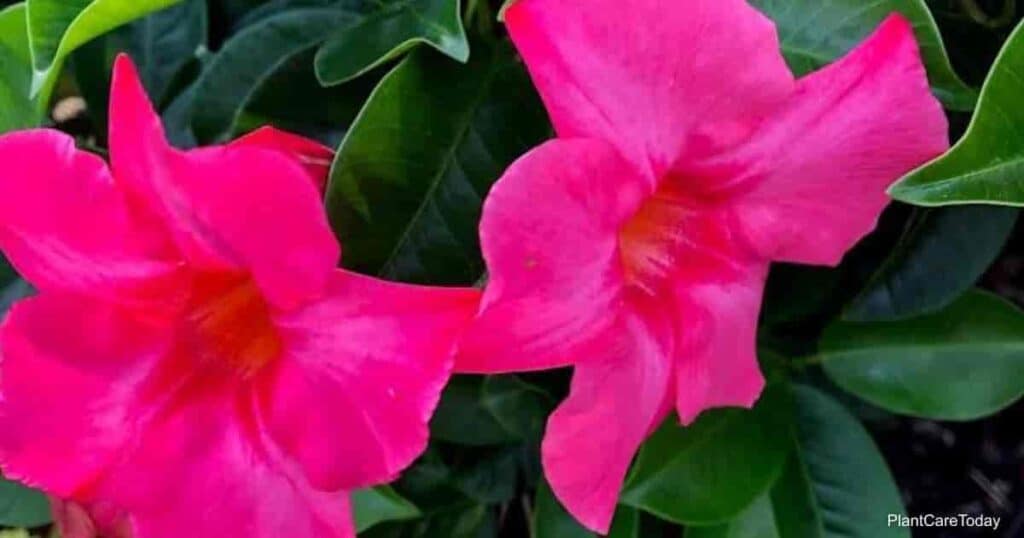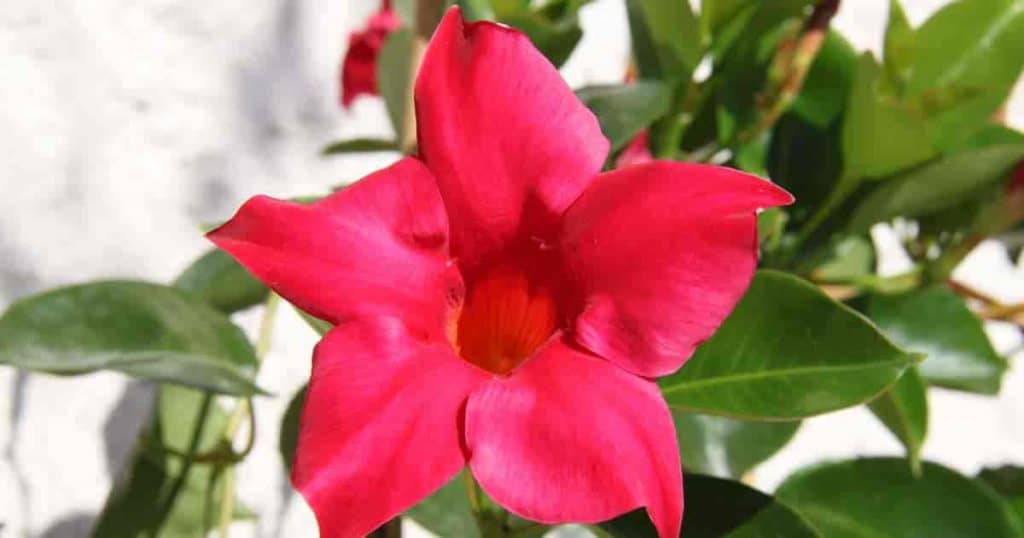Mandevilla vines can be found throughout the Americas in tropical and subtropical regions.
The Mandevilla genus consists of nearly 200 species and is best suited for USDA hardiness zones 9 to 11. Its vines can grow up to 20 feet long.

In northern climates, they are grown as annuals, but other varieties are grown as perennials.
They’re named after British gardener and diplomat Henry Mandeville and were first described as a benign genus in 1840.
Mandevilla Uses
Sometimes referred to as Chilean jasmine or rock trumpet, these plants are wonderful additions to the garden and indoor settings.
They’re usually trained on trellises or similar structures, providing a wall of green with wonderful pink, red, yellow, or white blooms.

The taller Mandevillas varieties are excellent climbers, but the smaller ones tend to form a more clumping habit unless trained to climb up a trellis.
These latter examples are often called Dipladenias and are excellent container plants.
They commonly attract beneficial animals and insects like bees, butterflies, and hummingbirds.
Mandevilla Types
With nearly 200 different species and numerous hybrids and cultivars, it can be difficult to know which plant to get first.

The following are the most popular Mandevilla varieties and are all great introductions to these wonderful flowering plants.
Dipladenia Plant
You might have a little trouble finding the Dipladenia plant if you don’t know what you’re looking for.
That’s because Dipladenia is actually the former genus name for the smaller, shrublike Mandevilla vine.
They were long considered a separate genus until recently, and the old name remains a common nickname for any smaller Mandevilla plant.

Dipladenias tend to be shorter and bushier, and the stems generally droop.
They also have slightly smaller flowers with more variation than the vining type, which often has red flowers.
The foliage is shorter and more heart-shaped than their vining kin as well.
However, the care for Dipladenias is virtually identical to that of traditional Mandevilla.
Mandevilla ‘Alice Du Pont’
Bearing dark green, wrinkled leaves and 4” inch-wide flowers bearing five-round red petals and a yellow throat, ‘Alice Du Pont’ is perhaps one of the most famous Mandevilla cultivars.

Alice Dupont mandevilla is hardy enough to handle winter weather as cold as zone 9.
Outdoors can climb to an impressive 20’ feet tall, but when planted in a pot, it will remain a far more manageable 5’ feet in height.
Mandevilla jamesonii
While not one of the more popular species out there, you can feel good about owning this native of Ecuador.
Listed as critically threatened, Mandevilla jamesonii can be difficult to find but is available for purchase.

Much like ‘Alice Du Pont,’ this plant will only grow to about 5’ feet in a container and will need a trellis to climb.
This plant won’t stand out from other species, but bringing one home can help prevent this plant from going extinct.
Mandevilla laxa
Laxa produces beautiful 3-inch-wide white flowers with a slightly yellow throat.
Up to 15 of these wonderful-smelling flowers can appear per woody stem, and outdoor specimens will reach 20’ feet tall with the proper support but will be much smaller if grown indoors in a container.

Awarded the Royal Horticultural Society’s Award of Garden Merit, this wonderful Mandevilla isn’t as cold-hardy as some other species and is usually grown in greenhouses or protected by glass.
However, it makes for a wonderful addition to your home when placed in a bright spot.
Mandevilla sanderi
When you want a Mandevilla with personality, it doesn’t get much better than this former Dipladenia.
While growing to a shorter 15’ feet outdoors, this native of Rio de Janeiro makes up for its height with one of the fastest-growing speeds of any Mandevilla.

The shrub has 2 ½” inch-dark green leaves and attractive red flowers with yellow stamens.
It’s not frost tolerant, but it can handle coastal conditions and is somewhat drought tolerant.
Mandevilla splendens
This winner of the Royal Horticultural Society’s Award of Garden Merit, this Rio de Janeiro native is another former Dipladenia.
It grows to a modest 10’ feet tall and has wide elliptical leaves about 8” inches long.

The rose pink flowers have a yellow throat and appear near the top of the plant.
It doesn’t like frost but does well as a container plant brought outdoors during the summer months.
Related: How to Overwinter Mandevilla – Yes there is a way to overwinter Mandevilla – Read more here.
Mandevilla Plants Interesting Introductions

- White Delight has soft stems and pretty, bright white flowers. Its vines attain a length of 12′ feet, but this plant is very accommodating when pruned to a smaller size and shape.
- Stars and Stripes boast red blooms with white stripes. Its leaves are large and glossy, and its vines can reach 12′ feet long.
- Summer Snow’s flowers are very large and dazzling white, offset by glossy, dark green leaves.
- Red Riding Hood produces impressive deep red flowers.
- Ruby Star’s flowers are an exceptionally deep red shade.
Yellow Delight (Pentalinon luteum) is not a true Mandevilla but a good imposter. It’s a low-growing shrub with jaunty yellow flowers that do very well as a hanging basket plant.
Quick Mandevilla Care Tips
Botanical Name: Mandevilla spp.
Pronunciation: (man-duh-VIL-luh SPLEN-denz)
Common Name: Chilean Jasmine, Rock trumpet
Native: North America, Central America, South America

Rose-colored trumpet-shaped flowers (rock trumpet) are borne on this handsome vine and are 3″ or more in diameter.
Its summer and early fall flowers are accented by leathery green leaves. It will climb and trail in pots. You can train Mandevilla to climb a 4’ foot trellis.
Give it a hanging basket in a sunny window if you prefer it long and trailing.
Light: Mandevilla grows best in full sun with at least 6 to 8 hours of direct sunlight daily. Give plants very high light indoors (near a a sunny south or east window), and outdoors, give them direct sunlight.
Temperature: Plants require warm temperatures from 65° to 80° Fahrenheit (18° to 27°C). They can tolerate 35° degrees Fahrenheit (2°C) without damage.
Water: Allow the surface of the potting soil to dry out between waterings.
Soil: Rich soil with good drainage and a slightly acidic to neutral pH; a potting mix combining peat moss, sand, and leaf mold also works well.
Humidity: High humidity levels (40% or more, if possible) with consistent moisture

Fertilization: Apply monthly when the plant is in its active growing season; otherwise, apply every two months. You could also apply liquid fertilizer at half-strength every two weeks from spring to fall.
Propagation: Stem cuttings of 4” to 6” inches (10 to 15 cm) with 4 or more leaves.
Special Care: When the plant starts to grow too many stems, repot it in a larger pot in a potting mix with good drainage and at least 50% organic matter. Prune them if they start to grow out of bounds or too large.
Common Pests Problems: Look carefully at the leaf nodes and axils for infestation of mealybugs, aphids, whiteflies, and red spider mites. If you find any, spray neem oil or insecticidal soap.
